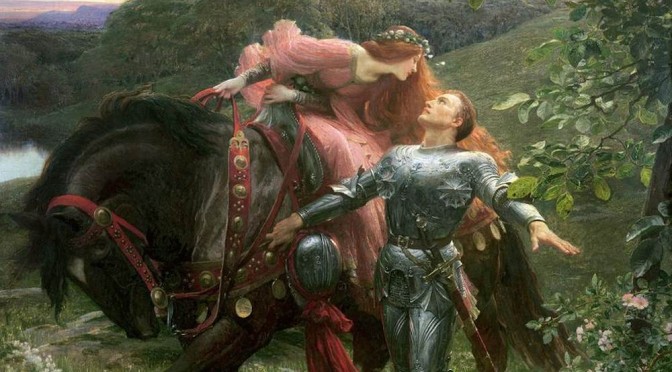 Thus in about 481 Western Europe was subdivided into eight major subdivisions of the Roman Empire. Riothemus in Britain, Syragius in Normandy, Anjou and the lands between Paris and Soisson together with Odoacer in Italy all in their own way supported the Eastern Emporer. In the South West, the Visigoths ran their territories as if they were still the Empire but with a Gothic aristocracy performing the role of the Senate and government. In the East and North East the Burgundians, Alamans and the Franks had taken control with very different structures. They created kingdoms and their leaders called themselves Kings.
It was in these kingdoms that the feudal system was invented. Unsure of the level of support which could be received from individual landowners, the Kings assumed ownership of all land and then reallocated it to his principal supporters who often included some of those who had possessed the land before the takeover. In return for the favour of the grant of land the “Feuar” promised loyalty, financia and military support. Many of these feuars were the Dukes and Comptes from the previous era. Eventually central control ceased. For their own survival, The Dukes and Comptes, had to negotiate arrangements with competing interests. Some Dukes pushed for total independence but found this to be a very dangerous policy. Most opted for swearing allegiance to one of the major developing powers. Near Fronyiers between Kingdoms, relationships were often short lived. Both Dukes and Comptes became adept at switching allegiances frequently as the balance of power changed,
The hierarchy of the Church of Rome, up to now totally separate from the state, was severely disrupted. By default local bishops aligned themselves to the nearest duke for protection. It was soon realised that dukes were too high profile, often attacked and replaced. Most bishops chose a safer option of aligning themselves with Comptes. The bishops first had to convince Individual Comptes that the church of Rome still had a role to play. It was in this period that the tradition originated that a Compte had the right to choose the Bishop whose diocese was located within his own territory. Naturally each Compte would choose a bishop whose views, religious and otherwise, coincided most closely with his own!Initially the code of chivalry was essentially simple.
Thus in about 481 Western Europe was subdivided into eight major subdivisions of the Roman Empire. Riothemus in Britain, Syragius in Normandy, Anjou and the lands between Paris and Soisson together with Odoacer in Italy all in their own way supported the Eastern Emporer. In the South West, the Visigoths ran their territories as if they were still the Empire but with a Gothic aristocracy performing the role of the Senate and government. In the East and North East the Burgundians, Alamans and the Franks had taken control with very different structures. They created kingdoms and their leaders called themselves Kings.
It was in these kingdoms that the feudal system was invented. Unsure of the level of support which could be received from individual landowners, the Kings assumed ownership of all land and then reallocated it to his principal supporters who often included some of those who had possessed the land before the takeover. In return for the favour of the grant of land the “Feuar” promised loyalty, financia and military support. Many of these feuars were the Dukes and Comptes from the previous era. Eventually central control ceased. For their own survival, The Dukes and Comptes, had to negotiate arrangements with competing interests. Some Dukes pushed for total independence but found this to be a very dangerous policy. Most opted for swearing allegiance to one of the major developing powers. Near Fronyiers between Kingdoms, relationships were often short lived. Both Dukes and Comptes became adept at switching allegiances frequently as the balance of power changed,
The hierarchy of the Church of Rome, up to now totally separate from the state, was severely disrupted. By default local bishops aligned themselves to the nearest duke for protection. It was soon realised that dukes were too high profile, often attacked and replaced. Most bishops chose a safer option of aligning themselves with Comptes. The bishops first had to convince Individual Comptes that the church of Rome still had a role to play. It was in this period that the tradition originated that a Compte had the right to choose the Bishop whose diocese was located within his own territory. Naturally each Compte would choose a bishop whose views, religious and otherwise, coincided most closely with his own!Initially the code of chivalry was essentially simple.
The last stage of change in the Roman empire consisted of the reemergence of the dux, or the retitling of the most powerful counts. There were still bishops and priests but the overall co-ordination of the church was weak.
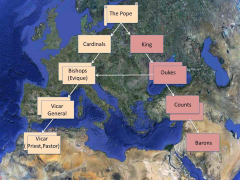 The Pope of the time developed the concept of right to rule. He maintained that Roman Emperor Constantine the Great had given the Popes of Rome the right to the temporal rule of the Western Empire. This was ultimately supported by documentation known as the “Donation of Constantine” (which much later was proved to be one of the greatest forgeries and therefore frauds, of all time). Nevertheless the Pope used this concept to intervene and appoint the untrustworthy devious, murderous, teenage leader of the Frankish tribe to be his Magister Militarum. A cursory examination of the titles chosen for the new Church of Rome hierachy shows that it was the Church itself which was intended to provide the civil governance.
The leader of the Franks was called Clovis and the Dynasty he founded the Merovingians.
There are many legends about why the Pope, chose Clovis, but it was really because he permitted the Church of Rome to adopt, at least in the short term, the role it had assigned to itself - to become the spiritual and temporal ruler of the Western Empire. Clovis became the classic Client King. His job was simply to use his ruthless political and military skills to eliminate the opposition, which he did, with brutal efficiency.The conquest of Clovis and his deal with the church transformed this into the first phase of the feudal system.
The Pope of the time developed the concept of right to rule. He maintained that Roman Emperor Constantine the Great had given the Popes of Rome the right to the temporal rule of the Western Empire. This was ultimately supported by documentation known as the “Donation of Constantine” (which much later was proved to be one of the greatest forgeries and therefore frauds, of all time). Nevertheless the Pope used this concept to intervene and appoint the untrustworthy devious, murderous, teenage leader of the Frankish tribe to be his Magister Militarum. A cursory examination of the titles chosen for the new Church of Rome hierachy shows that it was the Church itself which was intended to provide the civil governance.
The leader of the Franks was called Clovis and the Dynasty he founded the Merovingians.
There are many legends about why the Pope, chose Clovis, but it was really because he permitted the Church of Rome to adopt, at least in the short term, the role it had assigned to itself - to become the spiritual and temporal ruler of the Western Empire. Clovis became the classic Client King. His job was simply to use his ruthless political and military skills to eliminate the opposition, which he did, with brutal efficiency.The conquest of Clovis and his deal with the church transformed this into the first phase of the feudal system.
Now there was a clearly defined structure and one in which the Church provided the administration including the laws of the realm. It can be seen clearly why cardinals aligned with nations and bishops aligned with Dukedoms.
Lords of the Manor had to provide Feudal services to Barons (Seigneurs in France). One way of doing this was to provide members of his family to act as squires to the Barons. Squires were unpaid servants who in return were trained to be mounted fighting men.
 At the age of 20 they would be knighted, a ceremony originally performed in the local church without the accolade (dubbing ceremony). As knights they swore allegiance to the baron and promised to fight for whatever cause the barons deemed to be rightful and worthy. The Baronial castle initially housed all the knights.
At the age of 20 they would be knighted, a ceremony originally performed in the local church without the accolade (dubbing ceremony). As knights they swore allegiance to the baron and promised to fight for whatever cause the barons deemed to be rightful and worthy. The Baronial castle initially housed all the knights.
 The Knights imposed the barons will on the area allocated to the baron by whoever he swore fealty.
the feudal system was totally structured around this system of service and reward. At any level the accumulation of land, wealth could open a door to the level above.The Knights imposed the will of the Baron on the area allocated to the Baron by whoever he swore fealty.
The Knights imposed the barons will on the area allocated to the baron by whoever he swore fealty.
the feudal system was totally structured around this system of service and reward. At any level the accumulation of land, wealth could open a door to the level above.The Knights imposed the will of the Baron on the area allocated to the Baron by whoever he swore fealty.
The feudal system was totally structured around this system of service and reward. At any level the accumulation of land, wealth could open a door to the level above. The knights had no need worry about which Earl,or King they fought for, their baron made those decisions for them. Kings tried to ensure that even when they arranged beneficial marriages, Earls and Barons could not accumulate conjoined territories. If they did acquire additional territory it should be geographically separated.
 A dozen mounted knights could control an area of sixteen miles square. (250 Square Miles) but at night both they and their horses were vulnerable so they needed the protection of secure walls.The allocation of land to an individual baron was itself structured. Though modifications might be made to allow for geographical features the basic subdivision was 16 Miles square. This was considered to be the limit of land which could be controlled by a mounted squad of 12 knights.Groups of barons swore allegience to Earls ( Comptes in France). The Earls in turn swore allegiance to a King. Therefore at least in theory the kings will was known and implemented thought the kings realm. In practicee both earls and barons tweaked their understanding of the King’s will to suit themselves thus by eleven fifty the Kings of England found it necessary to have travelling judges, who, through the medium of court sessions tried to impose the Kings will uniformly over the kingdom.
A dozen mounted knights could control an area of sixteen miles square. (250 Square Miles) but at night both they and their horses were vulnerable so they needed the protection of secure walls.The allocation of land to an individual baron was itself structured. Though modifications might be made to allow for geographical features the basic subdivision was 16 Miles square. This was considered to be the limit of land which could be controlled by a mounted squad of 12 knights.Groups of barons swore allegience to Earls ( Comptes in France). The Earls in turn swore allegiance to a King. Therefore at least in theory the kings will was known and implemented thought the kings realm. In practicee both earls and barons tweaked their understanding of the King’s will to suit themselves thus by eleven fifty the Kings of England found it necessary to have travelling judges, who, through the medium of court sessions tried to impose the Kings will uniformly over the kingdom.
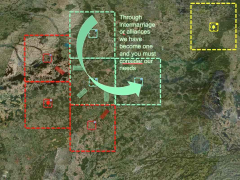 As time passed some wealthy Barons became “powerful”. Their armies, with knights as the backbone had the capability to depose Kings. Kings therefore changed the code of chivalry so that only they could award the accolade. Knighting ceremonies were centralized. Knights may have been trained by Barons but once knighted then owed their allegiance direct to a ruler.As time passed some wealthy Barons became “powerful”. Their armies, with knights as the backbone had the capability to depose Kings. Kings therefore changed the code of chivalry so that only they could award the accolade. Knighting ceremonies were centralized. Knights may have been trained by Barons but once knighted then owed their allegiance direct to a ruler.
As time passed some wealthy Barons became “powerful”. Their armies, with knights as the backbone had the capability to depose Kings. Kings therefore changed the code of chivalry so that only they could award the accolade. Knighting ceremonies were centralized. Knights may have been trained by Barons but once knighted then owed their allegiance direct to a ruler.As time passed some wealthy Barons became “powerful”. Their armies, with knights as the backbone had the capability to depose Kings. Kings therefore changed the code of chivalry so that only they could award the accolade. Knighting ceremonies were centralized. Knights may have been trained by Barons but once knighted then owed their allegiance direct to a ruler.
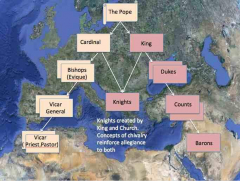 The knighting ceremony was invented to achieve this end. Towards the end of their training squires would be brought together in an experience intended to accentuate the importance of their mission and their duty of allegiance to their sovereign.The knighting ceremony was often preceded with ritual bathing,fasting and an overnight vigil before an altar.
The knighting ceremony was invented to achieve this end. Towards the end of their training squires would be brought together in an experience intended to accentuate the importance of their mission and their duty of allegiance to their sovereign.The knighting ceremony was often preceded with ritual bathing,fasting and an overnight vigil before an altar.
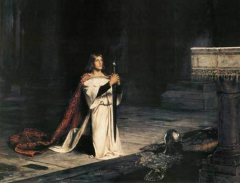 The knighting ceremony was often preceded with ritual bathing,fasting and an overnight vigil before an altar. The Roman church played a part in this change. It came to realise the significance of the ceremonies it had long presided over in local churches and subtly intervened in the training process. Squires were taught that they must not only fight for their feudal Lord and King but for God and in particular the requirements of God as expressed by the Roman Church. The knighting ceremony became as a sacrament of the church The Roman church played a part in this change. It came to realise the significance of the ceremonies it had long presided over in local churches and subtly intervened in the training process. Squires were taught that they must not only fight for their feudal Lord and King but for God and in particular the requirements of God as expressed by the Roman Church. The knighting ceremony became as a sacrament of the church.
The knighting ceremony was often preceded with ritual bathing,fasting and an overnight vigil before an altar. The Roman church played a part in this change. It came to realise the significance of the ceremonies it had long presided over in local churches and subtly intervened in the training process. Squires were taught that they must not only fight for their feudal Lord and King but for God and in particular the requirements of God as expressed by the Roman Church. The knighting ceremony became as a sacrament of the church The Roman church played a part in this change. It came to realise the significance of the ceremonies it had long presided over in local churches and subtly intervened in the training process. Squires were taught that they must not only fight for their feudal Lord and King but for God and in particular the requirements of God as expressed by the Roman Church. The knighting ceremony became as a sacrament of the church.
From Chivalry by Leon Gautier(1850) but based on the Song of Roland ( 1200)
Thou shalt believe all that the Church teaches, and shalt observe all its directions.
Thou shalt defend the Church.
Thou shalt repect all weaknesses, and shalt constitute thyself the defender of them.
Thou shalt love the country in the which thou wast born.
Thou shalt not recoil before thine enemy.
Thou shalt make war against the Infidel without cessation, and without mercy.
Thou shalt perform scrupulously thy feudal duties, if they be not contrary to the laws of God.
Thou shalt never lie, and shall remain faithful to thy pledged word.
Thou shalt be generous, and give largess to everyone.
Thou shalt be everywhere and always the champion of the Right and the Good against Injustice and Evil.
There was a by-product of this centralisation. By the middle of the 14th century, knights would feel free to release themselves from life long service to a single feudal overlord. If not specifically called to service by the King they began to roam the western world depicting themselves as fighting against “injustice” and righting wrongs. In practice knights fight for any cause for which will give them a suitable reward. Relatively large numbers of them move around Europe, acting as mercenaries, most of them governed by the chivalric code, but some quite specifically ignoring it!
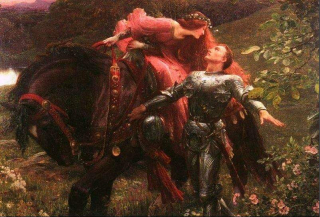 There was a by-product of this centralisation. By the middle of the 14th century, knights would feel free to release themselves from life long service to a single feudal overlord. If not specifically called to service by the King they began to roam the western world depicting themselves as fighting against “injustice” and righting wrongs. In practice knights fight for any cause for which will give them a suitable reward. Relatively large numbers of them move around Europe, essential acting as mercenaries, most of them governed by the chivalric code, but some quite specifically ignoring it! ( see theThe itinerant nature of their existence provided a perfect match to the culture of the courts of love, the culture considered heretical by the Roman Church. Itinerant knights could visit a court and express and win the love of a lady, even if she was married. Her husband might be absent on some mission of his own, but his absence is not an absolute requirement. Even in the husband’s presence, it was considered permissible for the visitor to make his suit. However anything that followed was totally at the lady’s discretion. It emphasised the ethereal quality of true love.
There was a by-product of this centralisation. By the middle of the 14th century, knights would feel free to release themselves from life long service to a single feudal overlord. If not specifically called to service by the King they began to roam the western world depicting themselves as fighting against “injustice” and righting wrongs. In practice knights fight for any cause for which will give them a suitable reward. Relatively large numbers of them move around Europe, essential acting as mercenaries, most of them governed by the chivalric code, but some quite specifically ignoring it! ( see theThe itinerant nature of their existence provided a perfect match to the culture of the courts of love, the culture considered heretical by the Roman Church. Itinerant knights could visit a court and express and win the love of a lady, even if she was married. Her husband might be absent on some mission of his own, but his absence is not an absolute requirement. Even in the husband’s presence, it was considered permissible for the visitor to make his suit. However anything that followed was totally at the lady’s discretion. It emphasised the ethereal quality of true love.
What is most significant, almost incredible, is that the chivalric code, encouraged and developed by the Roman Church, is best remembered by what it drew from a alternative which the Church considered to be heretical and depraved.
 By 1350 the code of chivalry was being threatened on many fronts. The increasing use of larger armies and the imposition of battlefield tactics tends to confict with concepts of chivalrous combat.
The battle of Muret ( see Albigensian Crusade) was lost by Pedro of Aragon because he wanted to win in a chivalrous manner, a concept not shared by his opponents.
The lessons from that defeat had been learned and learned well.By 1350 the code of chivalry was being threatened on many fronts. The increasing use of larger armies and the imposition of battlefield tactics tends to confict with concepts of chivalrous combat.
By 1350 the code of chivalry was being threatened on many fronts. The increasing use of larger armies and the imposition of battlefield tactics tends to confict with concepts of chivalrous combat.
The battle of Muret ( see Albigensian Crusade) was lost by Pedro of Aragon because he wanted to win in a chivalrous manner, a concept not shared by his opponents.
The lessons from that defeat had been learned and learned well.By 1350 the code of chivalry was being threatened on many fronts. The increasing use of larger armies and the imposition of battlefield tactics tends to confict with concepts of chivalrous combat.
The battle of Muret ( see Albigensian Crusade) was lost by Pedro of Aragon because he wanted to win in a chivalrous manner, a concept not shared by his opponents.
The lessons from that defeat had been learned and learned well.
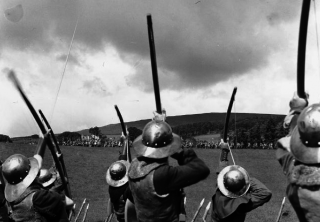 At Crecy the English Cavalry dismouted an closed ranks to emphasise that this was not going to be a chivalrous melee.
They then utilised massed archers using the longbow to decimate the French Cavalry at a greater distance than the French had judged to be possible.At Crecy the English Cavalry dismouted and closed ranks to emphasise that this was not going to be a chivalrous melee.
At Crecy the English Cavalry dismouted an closed ranks to emphasise that this was not going to be a chivalrous melee.
They then utilised massed archers using the longbow to decimate the French Cavalry at a greater distance than the French had judged to be possible.At Crecy the English Cavalry dismouted and closed ranks to emphasise that this was not going to be a chivalrous melee.
They then utilised massed archers using the longbow to decimate the French Cavalry at a greater distance than the French had judged to be possible.
 The use of machinery such as the trebuchet undermined cvoncepts of chivalry. These machines could kill indiscriminately at great distances.
Those using the machine did not know or see their victims who could be women or childrenThe use of machinery such as the trebuchet undermined cvoncepts of chivalry. These machines could kill indiscriminately at great distances.
The use of machinery such as the trebuchet undermined cvoncepts of chivalry. These machines could kill indiscriminately at great distances.
Those using the machine did not know or see their victims who could be women or childrenThe use of machinery such as the trebuchet undermined cvoncepts of chivalry. These machines could kill indiscriminately at great distances.
Those using the machine did not know or see their victims who could be and often were women or children.
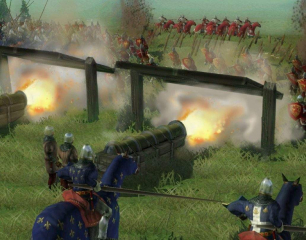 Finally waiting in the wings was the use of firearms. At the battle of Crecy, in addition to the longbow there were Ribaldis in use. Thses were devices for propelling large arrows, shot and grapeshot. The Ribaldis were not accurate but caused many injuries to the French and had a huge effect on French morale.Finally waiting in the wings was the use of firearms. At the battle of Crecy, in addition to the longbow there were Ribaldis in use. Thses were devices for propelling large arrows, shot and grapeshot. The Ribaldis were not accurate but caused many injuries to the French and had a huge effect on French morale.
Finally waiting in the wings was the use of firearms. At the battle of Crecy, in addition to the longbow there were Ribaldis in use. Thses were devices for propelling large arrows, shot and grapeshot. The Ribaldis were not accurate but caused many injuries to the French and had a huge effect on French morale.Finally waiting in the wings was the use of firearms. At the battle of Crecy, in addition to the longbow there were Ribaldis in use. Thses were devices for propelling large arrows, shot and grapeshot. The Ribaldis were not accurate but caused many injuries to the French and had a huge effect on French morale.
Within a decade cannon were in use on ships and being laboriously towed into position on the battlefield
